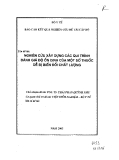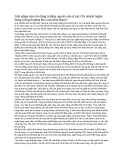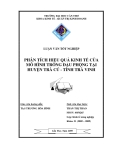Discussion
Discussion about the articles by E Lahde et al in Ann Sci For (1994) 51, 97-120: "Structure and yield of all-sized and even-sized conifer-dominated stands on fertile sites" and "Structure and yield of all-sized and even-sized Scots pine-dominated stands"
Pierre Duplat
(Office national des forêts, département des recherches techniques, 77306 Fontainebleau, France)
Each plot is considered as a stand, with its inventory, its total stem volume (tariff function(s)?), its dominant height and its total stem current increment.
I have some reservations about 2 papers by E Lähde et al in Annales des Sciences Forestières (1994) 51, 97-120, entitled: "Structure and yield of all-sized and even- sized conifer-dominated stands on fertile sites" and "Structure and yield of all-sized and even-sized Scots pine-dominated stands".
Precise criterions, applied to the all- species diameter histogram of each stand, make it possible to decide whether it belongs to 1 or the other of 2 groups of "structure": "all-sized" and "even-sized"; 83% of the stands may thus be classified in 1 or the other group, and constitute the material for the study.
INTRODUCTION
The stands belonging to each large group of structure are classified into 2 groups of "composition", depending on whether they include less or more than 120 broad-leaved trees per hectare: "coniferous", "mixed".
The "yield" of each group structure x com- position is judged on the basis of 2 results: - the mean of current increments for stands with a given standing volume (137 < V ≤ 167 m3/ha) - the mean of relative current increments (increment/volume) of all stands in the group.
The material used comes from the third national forest inventory 1951-1953 in southwestern Finland, on Myrtillus type sites or more fertile ones: temporary plots, 1 000 m2 in size, inventory by species and diam- eter class starting from the 2-6 cm class, measure of dominant height (100 largest trees/ha), and estimation of current volume increment over the 5 preceding years (by boring every tree?).
I will express the most important ones referring to the first paper, the second one using the same methodology.
For even-aged stands, dominant height is not a site index by itself, as it depends on age at a given site quality.
Current increment of a stand, at a given
For uneven-aged stands, it could roughly by assumed, if the 100 largest trees/ha were more or less at the same stage of maturity in every stand, but nothing ensures that this is the case here. Given the criterions used to classify the stands into groups of structure, it is even likely that the "all-sized" group includes part of the young even-aged stands.
So, site quality cannot be controlled by a consistent index in the present study, where the problem is still further complicated by the presence of several species. Stating that dominant height alone "may give a good base for comparisons of site quality" between stands, whether even-aged or uneven-aged, is not satisfactory.
time, mainly depends: i) on the quality of the site where it grows ii) on its specific composition iii) on its age, if it is an even-sized (even- aged) stand, or on its intimate structure (in ages, dimensions, spatial distribution) if it is an uneven-aged stand iv) incidentally and the above conditions being fixed, on its standing volume if it falls far below the biological maximum attainable under those conditions.
An explicit objective of the paper is to come to a conclusion, in this region and on these sites, about which structure, which composition, or which combinations, are better as far as volume yield is concerned. In my opinion, the method used and cur- sorily described does not fulfill this expec- tation; I will explain why.
Factor 2: composition of the stand
Being not too demanding about the def- inition of the factors and their levels, one can say that factor 2 (composition) and fac- tor 3 partly (large types of structure) are tested factors in the present paper. The other ones - factor 1 (site quality) factor 3 partly (age or intimate structure), factor 4 (volume) - are therefore to be controlled. Let us look at that.
Composition is explicitly tested as a factor in the paper, considering only 2 levels: "conif- erous" and "mixed". Therefore, it should not pose any special problem (apart from the varying proportions of spruce and pine).
Factor 1: site quality
However, one reservation must be made: stands are classified into "coniferous" or "mixed" according to a criterion which is an absolute number of stems per hectare; it is less demanding for young (and "all-sized") stands than for ageing ones. So, young stands showing a small proportion (5-10%) of broad leaves will be classified as "mixed", whereas similar but ageing ones, of whose increment is smaller, will be classified as "coniferous".
Comparisons between types of structure or composition make sense only for a given site quality. In the present study, the mate- rial used spreads over a large range of site quality (Myrtillus site type or more fertile); but site quality of the stands is not known, only their dominant height is.
A first remark is essential: the current volume increment of a stand at a given time is not its long-term yield, especially if it is an even-aged stand. I will come back to that point when examining factor 3. As this factor is not controlled, correla- tions may happen between site quality and other factors: it is even likely for the "com- position" factor, with broad-leaved trees being noticeably present upon certain site types rather than upon other ones.
Factor 4: standing volume
Factor 3: structure and age
Factor 3 is a composite, hierarchical factor with an upper stage: "structure" ("even- sized"/"all-sized") and a lower one: age for "even-sized" stands, intimate structure for "all-sized" stands.
It is not the value of standing volume per se that has an effect, even less a linear effect, upon current increment. It acts notice- ably, everything else (site quality, compo- sition, age or structure) being fixed, only as it may fall markedly below the correspond- ing maximum attainable volume. The rele- vant control variable would be rather the ratio of standing volume to that maximum, but this one is unknown here.
So, would even site quality and age or intimate structure be properly controlled in other respects, there would be little sense to work at a fixed absolute volume (152 m2/ha). There is no more sense to consider the rel- ative volume increment rate, as though standing volume were a capital proportion- ally yielding its annual interest. One may refer to Assmann (The principles of forest yield study, 1970, Pergamon Press, pp 229 sq) in this respect.
At the upper stage (the 2 groups of struc- ture), it is a tested factor in the paper. But, there too, a reservation must be made. Cri- terions used by the authors lead to classify young even-aged stands (eg 3 000 stems/ha with a mean diameter of 8 cm) as "all-sized"; the average histogram of stands classified as "even-sized" shows a lack of young stands. A certain number of such young stands, whose increment is larger than that of aged ones’ for the same levels of other factors, reinforced the "all-sized" group.
CONCLUSION
This use of standing volume is therefore not pertinent when the other factors are properly controlled. One cannot a fortiori hope it becomes relevant when these other factors are not controlled.
ment, lack of control of age - lack of control of site quality - control of standing volume that is not per-
At the lower stage (age or intimate struc- ture), it is obviously a factor to be controlled. Let us be more accurate: firstly, the "yield" of an even-aged stand is not its current incre- ment which strongly depends on age, but its mean increment over a rotation. More- over, this one depends on the rotation’s duration, which must therefore be fixed, for instance at the average duration imple- mented actually or at the duration leading to the maximum mean increment. If this mean increment is to be derived from the average of current increments observed at a given date on even-aged stands of differ- ent ages, all other factors being fixed, the age distribution of these stands must be uni- form over the chosen duration. This is not controlled in the present paper, the age of even-sized stands being unknown. "Yield" indicators obtained, with the method and material used in this study, do not seem to be relevant indicators for the reasons expounded here, among which I summa- rize the main ones: - confusion between yield and current incre-
- criterions, used to classify stands into groups, such as the appellations of these groups are not strictly consistent with the nature of the stands included.
tinent
As for uneven-aged stands, the ideal case is a stand whose intimate structure is kept stationary with enough standing material to avoid any noticeable loss of production, and whose current increment is constant over time: then it is equal to the mean increment. In general, it is very difficult to assess how far one stands from this ideal case, and the issue is not considered in this paper.
Therefore, these indicators do not allow, in my opinion, a conclusion about the respective yields of all-sized or even-sized and coniferous or mixed stands.
Recently, a colleague from our depart- ment (Demolis, 1993, "Étude de l’influence de la fertilité du sol sur le choix du traite- ment sylvicole des peuplements résineux jurassiens", document interne, départe- ment des recherches techniques ONF) conducted a comparative study about even-aged and uneven-aged high forest in the Jura range, on the basis of man-
agement records. Studied units were not plots, but whole forests, planned and man- aged for a long time according to one or the other structure (330 forests, 64 000 ha). He found that annual volume incre- ment, during the 10 or 20 years preceding the last revision of the management plan, was distinctly larger in the even-aged high forest group. He wisely did not conclude that the even-aged system is better than the uneven-aged one, but that forests so treated are likely to be standing on more fertile sites on average.
Reply note to P Duplat’s letter: "Yield comparisons among structurally all-sized and even-sized forest stands" by E Lähde, O Laiho, Y Norokorpi, T Saksa
parameters for comparing structurally dif- ferent stands. The Finnish forest site type system is not influenced by these prob- lems.
The group of the Myrtillus type and more fertile sites (Lähde et al, 1994a; Ann Sci For 51, 97-109) in the study material did not demonstrate any bias in favour of all-sized stands; instead, the distribution slightly favoured even-sized stands. The distribu- tion of the study stands by site type and structure class was in order of site fertility as follows (percent of sample plots):
INCREMENT CORRELATE WITH SIZE, NOT WITH AGE
The similarity of the stands’ tree species composition was another reason for com- bining the fertile site types to form 1 group. The material on pine-dominated stands (Lähde et al, 1994b; Ann Sci For 51, 111- 120) represented only 1 forest site type (Vaccinium type). It should be noted that southwestern Finland is a relatively uniform region in terms of climate and topography, and thus differs considerably from the mountain regions of Central Europe, for instance.
A long tradition in the Finnish forestry and National Forest Inventories is to apply the forest site type system when classifying for- est sites (ilvessalo, 1951). This classification is based on the ground cover vegetation and it is independent of the growing stock, its age, structure and species composition (Cajander, 1909, 1949; Vuokila, 1980). When comparing structurally all-sized and even-sized (all-aged and even-aged) stands, the forest site type system is more reliable than the site index (H 100) classifi- cation. The reason is that the harvesting of timber in all-sized stands takes place as single-tree selection, which also focuses on bigger trees. The low-thinning in even- sized stands focuses primarily on smaller trees. When comparing dominant height after different logging operations on a par- ticular site type, it is shorter in the all-sized stand than in the even-sized stand (eg Sterba and Monserud, 1993). The same applies to tree age when comparing stands with the same history of establishment (Lähde, 1995).
Increment in all-sized stands shows bet- ter correlation with size than with age (Cajander, 1934; Sarvas, 1944; Schütz, 1969; Indermühle, 1978). After releasing, the undergrowth trees generally attain the same size as trees which have always been released to grow in (Sarvas, 1951; Vaartaja, 1951; Vuokila, 1956; Klensme- den, 1984). Therefore, the age and height of the dominant trees are not reliable The dominant heights were presented in the publications for describing stands, but not for classifying site quality due to the aforementioned limitations. Nearly all sam- ple plots also included tree age measure- ments, but these parameters represented only the average age of the dominant trees.
BROAD-LEAVED TREES AND STRUCTURE INFLUENCE STAND INCREMENT
The mean ages of dominant trees in the study stands were as follows (fertile sites as an example):
Each sample plot was sampled for 10-20 sample trees and these were measured for their 5- and 10-year increments. The publi- cations set out only the 5-year increment data because the differences for the 10- year period were similar to the 5-year dif- ferences. The sample trees were used in determining the tree increment for each sample plot as a whole. This is often expressed using the concept yield, but more precisely, it is the increment and yield for a particular period.
Thus, the material did not differ any more than might be expected due to the different felling methods because all-sized stands should be harvested before reaching matu- rity. The general understanding appears to be that more research needs to be done on the subject of site index (H 100) classifica- tion for all-sized stands (Andreassen, 1994; Keller, 1994).
EACH SAMPLE PLOT REPRESENTED AN INDIVIDUAL STAND
The criterion used in the publications for sorting out pure coniferous stands and mixed ones was the number of broad-leaved trees. Instead, we could have used, for example, the proportion of the basal area or of volume as recommended by Dr Duplat. Both methods have their weaknesses, how- ever. In further studies, we have examined the dependence of yield on the proportion of broad-leaved trees (in terms of both stem tally and basal area) separately in each structural group. According to these results, it appears that when the proportion of broad- leaves increases to about 50% of the grow- ing stock, stand increment in both structural groups increases and then begins to decrease.
Using the number of broad-leaved trees as a criterion in classifying mixed stands may have caused some bias in favour of the even-sized stands and not the all-sized stands. The explanations for this are as fol- lows: 1) the relative proportion of broad- leaved trees in the even-sized mixed stand (because of its smaller overall stem tally) was greater than in the structurally all-sized mixed stand and 2) the broad-leaved trees in the even-sized stand were of greater aver- age size. The same stem tally as the limi- tation for a pure coniferous stand in both structural groups of advanced forests was
It is necessary to underscore the fact that each sample plot represented an individual stand. They were classified according to development stage, site type and structure class in the said publications. Adhering to inventory instructions, a sample plot was moved if it happened to fall on the boundary between 2 different stands (Ilvessalo, 1951). Thus, it was not possible for a particular sample plot to contain growing stocks dif- fering in age or otherwise, as is suspected by Dr Duplat. The growing stock on each sample plot was classified separately. The material included only advanced, primarily well- or satisfactorily-managed stands with normal growing stocks; even-sized stands were not classified as being all-sized. The stands were also identical in terms of their history of establishment - ie they were of natural origin.
1-175
Cajander AK (1909) Über Waldtypen. Acta For Fenn 1,
justified; eg due to differences in the stem diameter distribution, ecological-biological factors (litter etc).
Acta For Fenn 56, 1-71
Cajander AK (1949) Forest types and their significance.
Ilvessalo Y (1951) III valtakunnan metsien arviointi. Suunnitelma ja maastotyön ohjeet. Summary: Third national forest survey of Finland. Plan and instruc- tions for field work. Commun Inst For Fenn 39, 1- 67
Indermühle MP (1978) Struktur-, Alter-, und Zuwachs- untersuchungen in einem Fichten-Plenterwald de subalpinen Stufe. Beiheft zu den Zeitschriften des Schweizerischen Forstvereins 60, 98 p
Keller W (1994) Standörtliche Inhomogenität von ertragskundlichen Versuchsflächen - eine Ursache von Fehlschlüssen. Schweiz Z Forstwes 145, 1031- 1038
Klensmeden U (1984) Stamvis blädning. Några studier på två försöksytor i Dalarna. Examensarbete 1984-1986. Sveriges lantbruksuniversitet. Institu- tionen för skogsskötsel. Umeâ, 38 p
Lähde E (1995) Metsää puilta. Vihreä Eämänsuojelun
liitto. Hakapaino Helsinki, 112 p
One of the results in our studies was that all-sized stands grew better (with statistical significance) than equal even-sized stands with the equal growing stock volumes. In the material as a whole, the increment of even-sized stands was slightly better than that of all-sized stands when examining stands dominated by spruce; however, this difference was not statistically significant despite the extensive material used. The results covered, of course, only that stage in stand development that the sampling data represented. It should be noted that the growing of even-sized stands (during the rotation) includes regeneration and a fairly long period after regeneration when the annual volume increment is below average. Our subsequent studies dealing with other research material, and also arranged com- parative field trials, support the results pre- sented in the publications.
Lähde E, Laiho O, Norokorpi Y, Saksa T (1994a) Struc- ture and yield of all-sized and even-sized conifer- dominated stands on fertile sites. Ann Sci For 51, 97-109
Lähde E, Laiho O, Norokorpi Y, Saksa T (1994b) Struc- ture and yield of all-sized and even-sized Scots pine- dominated stands. Ann Sci For 51, 111-120
Sarvas R (1951) Tutkimuksia puolukkatyypin kuusikoista. Summary: Investigations into the spruce stands of Vaccinium type. Commun Inst For Fenn 39, 1-82
Sterba H, Monserud RA (1993) The maximum density concept applied to uneven-aged mixed-species stands. For Sci 39, 432-452
Cajander EK (1934) Kuusen taimistojen vapauttamisen jälkeisestä pituuskasvusta. Commun Inst For Fenn 19, 1-53
Vaartaja Y (1951) Alikasvosasemasta vapautettujen männyn taimistojen toipumisesta ja merkityksestä metsänhoidossa. Summary: On the recovery of released pine advance growth and its silvicultural importance. Acta For Fenn 58, 1-133
REFERENCES
Vuokila Y (1956) Etelä-Suomen hoidettujen kuusikoiden kehityksestä. Summary: On the development of man- aged spruce stands in southern Finland. Commun Inst For Fenn 48, 1-138
Vuokila Y (1980) Metsänkasvatuksen perusteet ja
Andreassen K (1994) Development and yield in selection
menetelmat. WSOY, Helsinki-Porvoo, 256 p
forest. Commun Skogsforsk 47, 1-37
In conclusion, there is an increasing necessity for scientific debate on the sub- ject of stand structure and species compo- sition. This demand involves the interna- tional conventions on forest biodiversity and ecological sustainability. The requirement of biodiversity will most probably be extended to the within-stand level, too. When this happens, there will be an even greater demand for scientific knowledge on the functioning of structurally all-sized mixed stands. We wish to express our warmest appreciation to Dr Duplat for the active inter- est afforded to our research work.




































